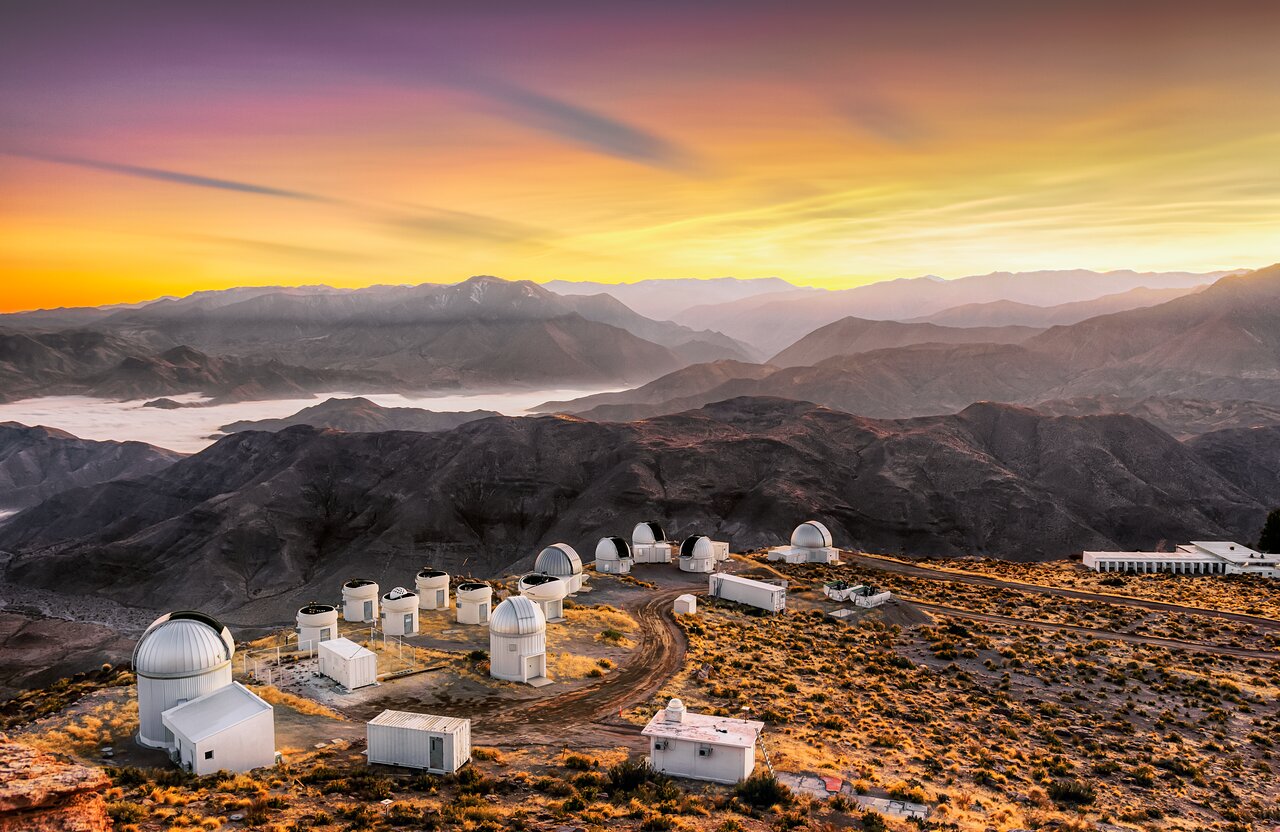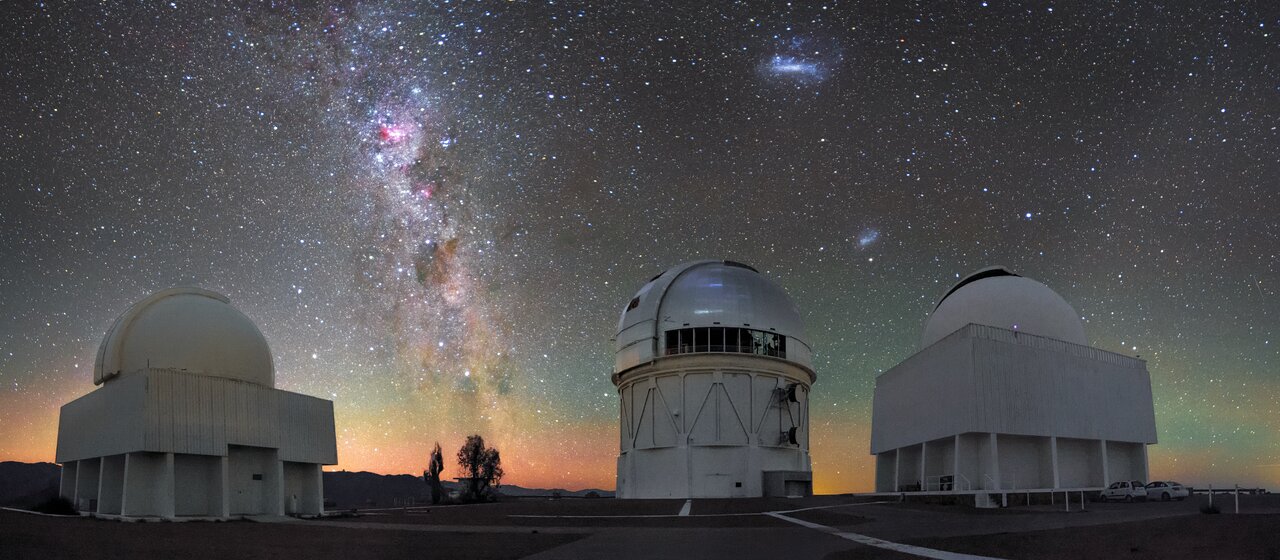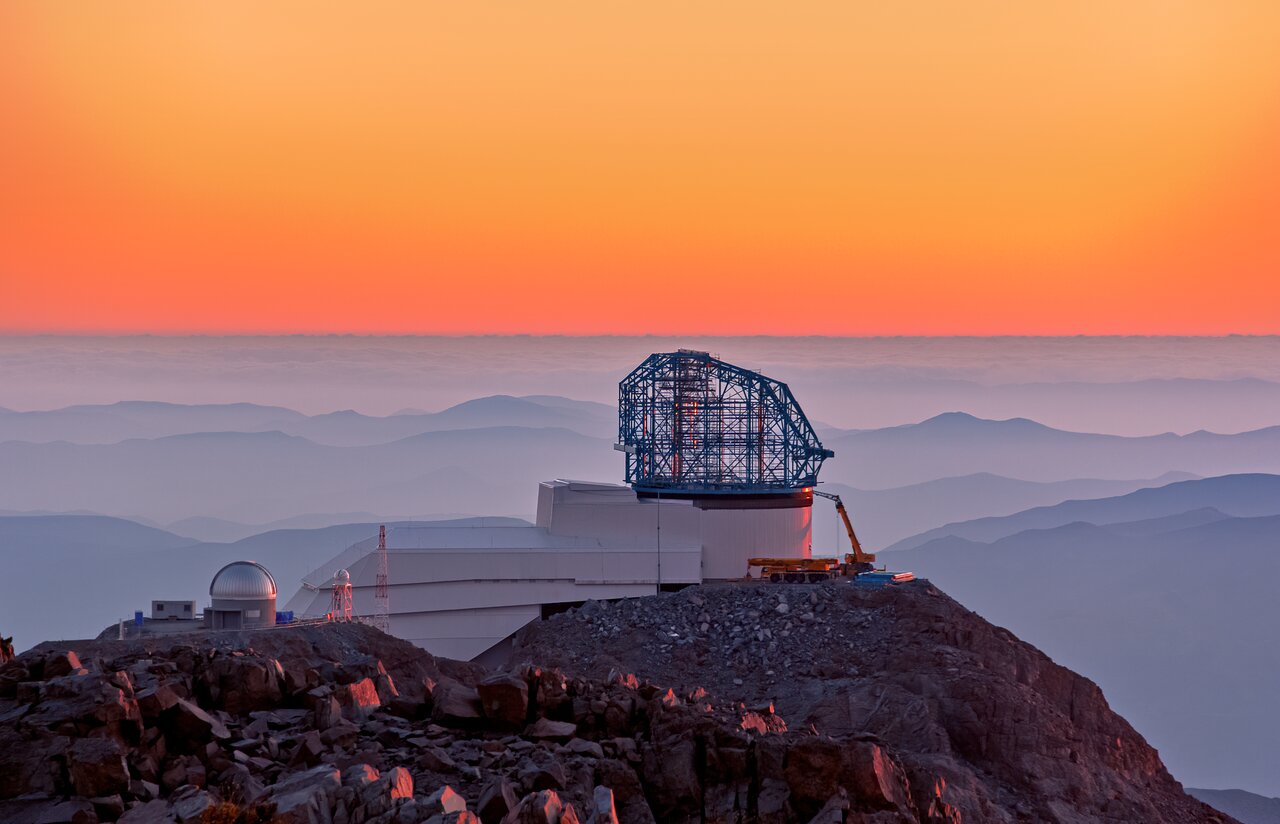
60 Years of Discovery from Cerro Tololo, the Observatory on the ‘Edge of the Abyss’
On 23 November 1962 astronomers and engineers selected Cerro Tololo as the ideal site for a new observatory, launching an unprecedented era of exploration, discovery, and learning.
23 Nov. 2022
High in the mountainous Coquimbo Region of Chile stands a peak called Cerro Tololo, whose name singles it out as a curiosity among its neighbors. “Tololo” means “at the edge of the abyss,” an evocative description thought to have been given to the mountain by the ancient Diaguita people living in surrounding valleys, in reference to how it drops sharply away on its northern side. But the name is perhaps even more apt now, because the summit has become an important viewing point from which we gaze into another abyss — the vast expanse of the Universe.
Today marks the 60th anniversary of the decision to build an observatory on Cerro Tololo’s summit, 2200 meters (7200 feet) above sea level.
Six decades on, Cerro Tololo Inter-American Observatory (CTIO) is home to over 40 telescopes, including several tenant observatories, offering astronomers from across the globe pristine views of the southern skies.
The Víctor M. Blanco 4-meter Telescope, commissioned in 1974, now features the Dark Energy Camera (DECam), which was designed specifically for the Dark Energy Survey. Meanwhile, the SMARTS Consortium operates four telescopes at CTIO. These contribute to a wide range of astronomical fields, from discovering new exoplanets to revealing the chemical composition of celestial bodies through spectroscopy. But how was Cerro Tololo’s previously arid mountain top transformed into the thriving hub of science it is now?
The story begins in 1958, when there were only 10 astronomical observatories in the southern hemisphere, none of whose locations had been specifically chosen with viewing conditions in mind. This dearth of facilities made whole-sky surveys extremely difficult, putting limits on the questions that astronomers could explore.
What’s more, some of the most fascinating celestial objects — including the Magellanic Clouds and the Carina-Centaurus region of the Milky Way, which is brimming with nebulae — lie in the southern skies. As such, they were out of sight of the best telescopes of the time, which were all in the northern hemisphere.
So in June 1958, while visiting the Yerkes Observatory, Federico Rutllant of the University of Chile suggested to his fellow astronomers the idea of a world-class cooperative observatory in Chile, to expand their views of the sky.
In 1960, with encouragement from the National Science Foundation (NSF), the Association of Universities for Research in Astronomy (AURA) took up the idea and agreed to lead the endeavor. The “Chile project”, as it was then called, was to be coordinated by astronomers based at Kitt Peak National Observatory (KPNO) in Tucson, Arizona.
It appears that no time was wasted, because KPNO’s annual report for the year 1960–1961 records that site surveys in Chile had already begun.
Over the following months, astronomers surveyed various mountains from Santiago to the north. Most candidates lay within the Atacama Desert, whose extremely dry atmosphere creates excellent viewing conditions, with minimal water vapor interfering with light before it reaches the telescopes. But the surveys also extended just south of the Atacama into the Coquimbo region, where the mountains run closer to the sea than anywhere else in the country. Here, the atmospheric, oceanic and geographic features combine to treat observers to exquisite views of the night sky.
After more than a year of site testing the decision came down to two locations, both in the Coquimbo region — Cerro Tololo and a mountain further north. While both mountains were close to cities and ports, those nearest Tololo — the cities of Vicuña and La Serena, as well as the port of Coquimbo — were larger than those near the other candidate site. Tololo was also closer to the only international airport in Chile at Santiago (though still 500 kilometers — over 300 miles — away), an advantage if equipment needed to be flown in. Ultimately, these practicalities swung the balance.
On 23 November 1962 it was officially decided that Cerro Tololo would be the location of the new observatory, which, from then on, was named Cerro Tololo Inter-American Observatory, or CTIO.
"It was very iconic for the observatory to take the name of the mountain,” says Leonor Opazo, administrative manager at CTIO, “because of the meaning of ‘Tololo’ in the native dialect here, and because of the objective of creating the observatory. In a way, it validated and respected Indigenous culture. If you come to Chile and say ‘Tololo,’ everyone knows you’re talking about a telescope in the north, and about astronomy."
Just two days after the decision, on 25 November 1962, AURA bought land of almost 30,000 hectares (over 74,000 acres) in area, with Tololo near its center; and on 2 December, a symbolic flag hoisting took place on Tololo. Jurgen Stock, who had been overseeing the site surveys and who would become CTIO’s first director, wrote about this flag hoisting in his diary.
He recorded how two seven-meter (23-foot) eucalyptus poles were brought up the mountain by a mule that was specially trained to carry this cumbersome cargo by walking back and forth several times at each sharp turn. “The trip to Los Placeres was without mishaps,” Stock wrote, “but of course rather slow.”
Yet the effort involved in the flag hoisting barely hinted at the work that lay ahead. At that time, the peak could only be reached by a horseback ride of about 10 hours, with an overnight stay halfway up. The first task was therefore to build roads up the mountain, connecting to Vicuña and La Serena. Access to water also had to be established, which was done by setting up a system to pump water from two springs about a kilometer (just over half a mile) below the summit.
If that weren’t enough, the very mountaintop itself had to be flattened to create an even platform for the telescopes. This was done in early 1964, the rocky surface being reduced to a level 14 meters (56 feet) below the original summit. The same year, excavations began for buildings to house the first telescopes, and AURA was careful to adopt a strict code for making them earthquake-resistant.
But the challenges were not only physical. As Chile’s first international observatory, CTIO faced significant administrative and political hurdles, and the University of Chile’s support was invaluable in overcoming them. Since the planning was being coordinated from KPNO, the university offered AURA the radio-communication wavelengths assigned to it to ensure quick communication, and the first radio messages were exchanged between KPNO and CTIO in February 1964.
The University of Chile also sponsored CTIO in obtaining duty-free importation rights from the Chilean government. AURA even had to obtain mining rights to its land — since these do not automatically belong to the landowner in Chile — to prevent anyone else from doing so, and thus protect the site for astronomy.
Throughout 1967 several buildings were completed and telescopes were installed, including the SMARTS 0.9-meter Telescope and SMARTS 1.5-meter Telescope, which are still in operation now as part of the SMARTS Consortium of telescopes. In November 1967 the 1.5-meter telescope saw first light, and the official inauguration of CTIO took place the next day.
By that time, funding had already been pledged for a 4-meter telescope on the mountain, ensuring that the observatory would be a truly world-leading one. A few years later, in June 1973, the components for the telescope arrived in the port of Coquimbo in 86 boxes, collectively weighing 500 tons.
After painstaking transportation and assembly at the summit, the 4-meter telescope, which was the southern hemisphere’s largest telescope at the time, started operating in 1976. It was named the Víctor M. Blanco 4-meter Telescope, after CTIO’s second director in 1995.
By the end of 1975, just 13 years after the decision to build an observatory on Cerro Tololo, eight telescopes were operating there.
Since then, the observatory’s telescope population has continued to grow, and Tololo has collected plenty of scientific accolades along the way. Perhaps CTIO’s biggest achievement to date is the role it played in discovering the accelerating expansion of the Universe. In the 1990s the Víctor M. Blanco 4-meter Telescope contributed important observations to the High-Z Supernova Search Team, which was measuring how distant supernovae were receding from us, to understand how the cosmos was expanding. Looking at these and other observations, astronomers were astonished to find that the Universe seemed to be accelerating in its expansion — a discovery that won three scientists the Nobel Prize for Physics in 2011.
"It was very iconic for the observatory to take the name of the mountain,” says Leonor Opazo, administrative manager at CTIO, “because of the meaning of ‘Tololo’ in the native dialect here, and because of the objective of creating the observatory. In a way, it validated and respected Indigenous culture."
With the goal of understanding this perplexing result a new cutting-edge instrument — the dark Energy Camera (DECam) — was designed, built and installed at the Blanco Telescope with funding from the Department of Energy (DOE) and the National Science Foundation (NSF). This high-performance, wide-field CCD imager boasts 62 science CCDs and 12 CCDs for guiding and focus, totaling 570 megapixels, and images a 3-square-degree field (2.2 degrees wide). Over 6 years (2013–2019) DECam performed the Dark Energy Survey (DES), an international, collaborative effort to map hundreds of millions of galaxies, detect thousands of supernovae, and find patterns of cosmic structure that are being analyzed to probe the nature of the mysterious dark energy that is accelerating the expansion of our Universe.
In addition to carrying out the DES, DECam has made several exciting discoveries. It contributed to the first detection of an electromagnetic counterpart to a gravitational wave event in 2017, which led to the 2017 Nobel Prize in Physics. Last year, a group of students from Chicago using the DECam found the brightest known gravitationally lensed galaxy, and just last month astronomers using the same instrument spotted the largest potentially hazardous asteroid discovered in eight years. Notably, while no longer the largest telescope in the south, the Blanco telescope achieved another first place this year — as the most productive ground based optical-IR telescope based on the number and scientific impact of publications over the last five years.
And there are no signs that CTIO is slowing down. It has even grown beyond the mountain it was named after, now also operating the SOAR Telescope on the nearby Cerro Pachón. Excitingly, Vera C. Rubin Observatory is also under construction there. This new facility will undertake transformational deep sky surveys, mapping the Milky Way more comprehensively than ever before, as well as identifying transient astronomical events of interest.
So the work continues to keep updating and improving CTIO’s capabilities, pushing technology to its limits, and expanding our knowledge of the Universe. Building an observatory anywhere is a colossal task, let alone on a mountaintop at an altitude of 2200 meters (7200 feet). But the extraordinary views of the Universe that the telescopes give us, and the profound insights they reveal, prove that it was — and is — worth every effort.






